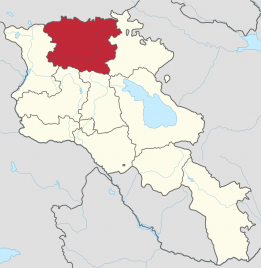Lori Province
Monday, December 5, 2022
Lori is a province (marz) of Armenia. It is located in the north of the country, bordering Georgia. Vanadzor is the capital and largest city of the province. Other important towns include Stepanavan, Alaverdi, and Spitak. It is home to the UNESCO World Heritage Sites of Haghpat and Sanahin monasteries and the well-preserved Akhtala monastery, where Armenians, Georgians, and Greeks make an annual pilgrimage on September 20–21.
The province was heavily damaged during the 1988 Armenian earthquake.
The province is served by the Stepanavan Airport.
The name Lori (Լոռի) is of Armenian origin (from Armenian "quail"), first appeared in the 11th century when King David I Anhoghin founded the fortified city of Lori. The fortress-city became the capital of the Kingdom of Tashir-Dzoraget in 1065. The name Lori later spread through the region and replaced the original name of Tashir.
History
Excavations conducted in 1931 testify that the region of modern-day Lori was most probably settled during the 1st half of the 2nd millennium BC. Later, the region became part of the Urartu Kingdom between the 8th and 6th centuries BC. After the Achaemenid invasion, the region became part of the 18th Satrapy of Persia. With the establishment of the Kingdom of Armenia in 331 BC, the region became part of the kingdom within the historic Gugark province, the 13th province of Greater Armenia. In the course of the 4th century, the region was ruled by members of the House of Mihran.
Following the partition of Armenia in 387 between the Byzantine Empire and Sassanid Persia, and the subsequent collapse of Arsacid Armenia in 428, Eastern Armenia including Gugark province became under the rule of Sassanid Persia. In 658, Armenia was conquered by the Arab invaders. At the end of the 9th century, most of the Gugark province became part of the newly established Bagratid Kingdom of Armenia. In 979, King Kiurike I founded the Kingdom of Tashir-Dzoraget under the rule of the Kiurikian dynasty and the protectorate of the Bagratid kings of Armenia. The capital of the kingdom was Matsnaberd (until 1065) and the Lori fortress. The Kiurikians ruled the kingdom until 1118 when Tashir-Dzoraget became part of the Kingdom of Georgia.
The Seljuks invaded the region in the early 12th century, but their rule did not last long and in 1118–1122 the Georgian king David the Builder conquered Lori and granted the rule to the House of Orbeli. The Orbeli's revolted unsuccessfully in 1177, after which a Kipchak named Kubasar was appointed spasalari of Lori. Later in 1185, the province became ruled by the Mkhargdzeli dynasty after Queen Tamar of Georgia appointed the Sargis Mkhargrdzeli as its governor. However, the region was devastated by the Mongol invasion of 1236, and the Zakarian dynasty declined by the 2nd half of the 14th century. After fall of the Kingdom of Georgia in 1490, Lori remained part of Kingdom of Kartli until the 16th century.
Lori was annexed by Safavid Persia as a result of the 1555 Peace of Amasya and became part of Persia's Kartli-Kakheti province. After Nader Shah's murder in 1747, the Georgian kingdoms of Kartli and Kakheti became independent and united into a single kingdom by 1762.
In 1800–01, together with the Georgian provinces of Kartli and Kakheti, Lori and Tavush were annexed by the Russian Empire to become part of the Georgia Governorate. Lori became officially part of the Russian Empire at the Treaty of Gulistan signed on 1 January 1813, between Imperial Russia and Qajar Persia, following the Russo-Persian War of 1804–13.
In 1862, Lori was transferred into the jurisdiction of the Tiflis Governorate. In 1880, Lori became part of the Borchali uyezd of the Tiflis Governorate. In the early 20th century, Lori was mostly populated by Armenians, with several Russian and Greek villages. In May 1918, the Ottoman Turkish forces moved towards Yerevan and Karakilisa (now Vanadzor). On 25 May 1918, the Armenians led by Garegin Nzhdeh fought against the Turkish forces led by Wehib Pasha, at the vicinity of Karakilisa. On 28 May 1918, the Turks retreated from Karakalisa, Abaran and Sardarabad, paving way towards the declaration of the Republic of Armenia on the same day.
In late 1918, Armenia and Georgia fought a border war over Lori. Lori was claimed by both countries after 1918, when both declared its independence from Russian empire. Initially, Georgia controlled Lori. After turning down Armenian ultimatum, Georgian forces were attacked by Armenians and pushed back to river Khrami. Georgians consolidated and counterattacked pushing Armeanian forces out of contested area. In January 1919, the British brokered a peace agreement which left northern Lori as a neutral zone between the two countries. When Armenia was invaded by Turkish forces in November 1920, Georgia occupied the whole province, with permission by the Armenian government. Following Armenia's Sovietization in December 1920, Lori was incorporated into Soviet Armenia on 6 November 1921.
During the Soviet period, modern-day Lori was divided into the raions of Kalinino, Tumanyan (Alaverdi until 1969), Kirovakan, Aragats, Spitak and Stepanavan. After the independence of Armenia, the 6 raions were merged as per the 1995 administrative reform, to form the Lori Province.





